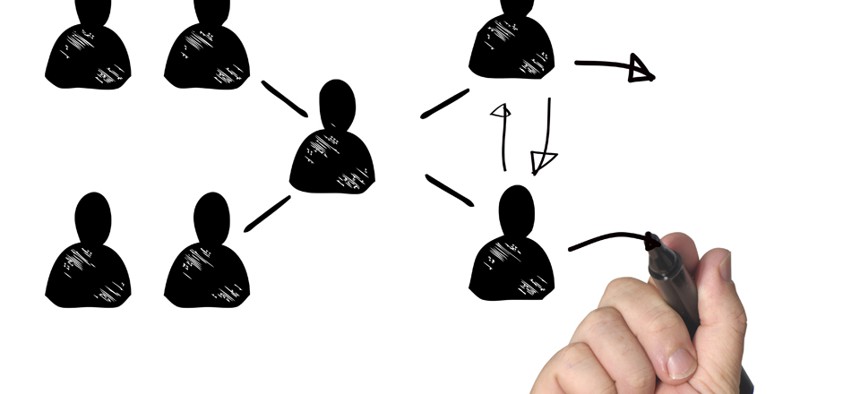Damn the Org Chart
Top-down doesn’t always work for today’s skilled, tech-savvy workforce.
When federal workers change jobs from one agency to another, the overall structure of their new home is often familiar. Although business unit titles might be different, the basic organizational design is usually comparable to that of their former agency.
This is because government agencies organize themselves into familiar patterns. The traditional org chart reflects a top-down military hierarchical model, with work compartmentalized by specialty and with members organized by rank. In the Army, it might be regiment, battalion, company and platoon. In the civilian world, it’s commonly department, division, branch and section, with each level populated mostly by employees at a specific General Schedule grade level. These levels are organized in nice symmetrical pyramids of four or five branches in a division, and three or four divisions in a department.
This model worked well for the federal government in the 1900s when its primary functions were the manufacture and distribution of things (weapons, equipment, currency and dams), or manual processing of paper (veterans’ claims, income tax returns, pay and benefits checks). It reflects a management style dependent on top-down orders from superiors to get work done. The model certainly makes sense for the military, but it doesn’t always work in the civilian world.
As more knowledge workers with high-level skills use technology to manage the business of government, the traditional organizational model doesn’t always work. In fact, it might be contributing to the inefficiencies we hear about in many government processes.
This era of lean budgets provides agencies an opportunity to experiment with nontraditional organizational models. The federal government shed 80,000 jobs in 2013, and more shrinkage looms in the foreseeable future. Agencies are coping with these reductions in predictable ways:
- Spreading the work among remaining workers
- Merging adjoining organizational units
- Eliminating supervisory positions and broadening the responsibilities of remaining supervisors
But in the end, they still remain locked in the familiar pyramid.
Private organizations are moving away from pyramid structures. Some companies have created self-directed teams whose structure is more circular than hierarchical, with several teams forming a business unit. Other companies are using matrix structures, where specialists work on more than one project across functional lines, and make use of shared resources that support various projects. A common theme is teams—individual, cross-functional, self-directed. Most examples are different from the vertical silos in government.
There are, of course, many obstacles to wholesale organizational change. For one, many parts of government have traditional missions that require traditional methods. For these organizations, the pyramid approach is the best way to accomplish work.
The biggest roadblock to experimentation with alternative structures are the government’s staffing, training and position classification systems, which do not lend themselves to recruiting and compensating employees in nonstandard structures. For example:
- Methods for assessing qualifications and screening candidates don’t necessarily produce the type of worker who would be effective in nontraditional roles that require different competencies.
- Career development and training systems are not designed to help individuals develop the skills required in these fluid structures.
- The General Schedule doesn’t accommodate the compensation, promotion and rewards systems needed to make nontraditional organizational structures work.
Despite these hurdles, it’s clear that government needs additional tools to organize and manage work, especially as the workforce shrinks and agencies are left to do the same or more work with fewer people. Certain parts of the government (NASA, Defense Department laboratories, and certain small independent agencies) already have varying forms of alternative structures. But they and other agencies could benefit from having additional freedom to experiment with a wider variety of ways to organize themselves to accomplish their missions.
It would be helpful if Congress exempted some agencies from existing hiring and pay rules to conduct pilots of new organizational structures—the type of demonstration projects envisioned in the president’s fiscal 2015 budget proposal.
Such experiments could result in novel and more efficient approaches to work that could be expanded to other agencies. They could also point the way to a future government that doesn’t always operate within the rigid boundaries of the traditional pyramid.
Henry Romero is a senior advisor with Federal Management Partners Inc. His 32-year career in human resources included positions at the Defense and Justice departments as well as the Office of Personnel Management.
(Image via winui/Shutterstock.com)



